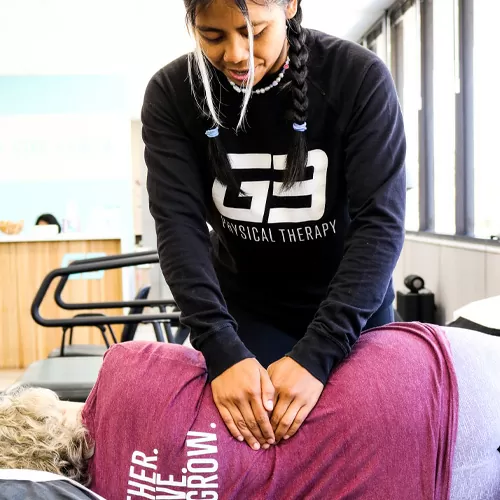 Find Relief from Osteoarthritis Pain
Find Relief from Osteoarthritis Pain
Are you experiencing persistent joint pain, particularly in a weight-bearing joint like your hip or knee? Do you ever notice a clicking or grinding sensation in your painful joint? If so, you may have developed osteoarthritis, the most common form of arthritis in the United States.
Arthritis is an umbrella term for over 100 conditions that cause joint inflammation and lead to pain and restricted mobility. The source of that inflammation will vary depending on the type of arthritis. In osteoarthritis, it’s caused by degeneration of the cartilage and bone tissue in the affected joint due to wear and tear.
Osteoarthritis has no cure and can profoundly impact your overall quality of life, making it harder for you to stay active, keep up with chores, and enjoy time with your loved ones. Fortunately, physical therapy at G3 Physical Therapy offers strategies and techniques to help you manage your symptoms, even delay or avoid surgical interventions.
If you’re tired of living with osteoarthritis pain, call us to schedule an appointment today!
Understanding Osteoarthritis: Symptoms and Causes
The primary symptoms of osteoarthritis are pain and stiffness in the affected joint. These symptoms often manifest in the following ways:
- Pain during activity but not while at rest
- Pain when you press on the joint
- Joint stiffness first thing in the morning, improves during the day, and worse again later in the day.
- Joint stiffness after prolonged periods in one position, like sitting, standing, or lying down.
- Noises in the joint, including creaking, cracking, or crunching
- More pain with initial activity, until your muscles are warmed up, and possible aggravation of pain post activity or workouts.
While any joint can develop osteoarthritis, it most commonly occurs in weight-bearing joints like the knees and hips. However, it’s also fairly common in the hands, spine, and feet.
The causes of osteoarthritis may seem complex, but it’s simple if you understand body mechanics. Osteoarthritis is a wear and tear issue. Research talks about various factors, but they all point to the same mechanism of injury. The factors include:
- Age: approximately 73% of people with the condition are 55 years or older.
- Past injuries to the joint
- Gender (women are more likely to develop it than men)
- Body weight & size.
- History of repetitive activities whether for a sport or work
- Genetic predispositions.
What do all these factors have in common? They are talking about factors that affect the mechanics of the joint.
- As we age, muscle mass is lost so less control of joint mechanics.
- Once a body part is injured, if not fully rehabilitated, it can lead to improper mechanics. An example is ankle sprains. Once you have one, many people get repeated sprains and other injuries can occur.
- Men have more testosterone that equates to more muscle mass and theoretically more strength to support the joint. Women tend to have more flexibility and mobility but need muscle strength to control the joint mechanics.
- Excessive body weight can place abnormal stress on the joint if there is not enough muscle mass ratio to control the joint motions due to gravity. The same can happen to taller people, they have longer lever arms to control in relation to gravity.
- Repetitive movements without proper alignment can develop damaging mechanical stress. This is like driving on a tire that needs more air, this changes the alignment of the car and can cause damage over time.
